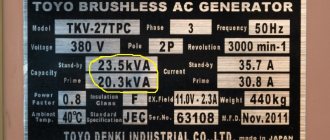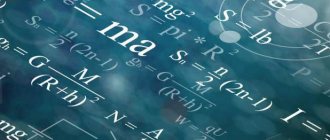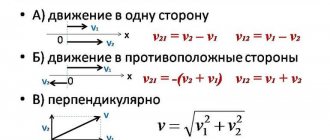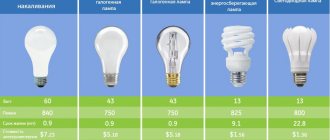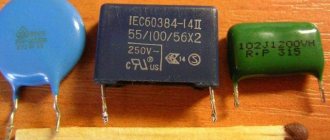How is electric current generated?
An electric current appears in a substance provided that there are free (unbound) charged particles. Charge carriers can be present in the medium initially, or formed with the assistance of external factors (ionizers, electromagnetic field, temperature).
In the absence of an electric field, their movements are chaotic, and when a substance is connected to two points, the potential differences become directed - from one potential to another.
The number of such particles affects the conductivity of the material - they distinguish between conductors, semiconductors, dielectrics, and insulators.
Direct and alternating current
Types of electric current
The next question we propose to understand is: what is alternating current and direct current. After all, many do not quite correctly understand these concepts.
D.C
Constant is a current that does not change its magnitude and direction over time. Quite often, pulsating current is also considered constant, but let’s talk about everything in order.
D.C
- Direct current is characterized by the fact that the same number of electrical charges constantly replace each other in one direction. Direction is from one pole to the other.
- It turns out that a conductor always has either a positive or a negative charge. And over time this remains unchanged.
Note! When determining the direction of direct current, there may be disagreements. If the current is generated by the movement of positively charged particles, then its direction corresponds to the movement of the particles. If the current is formed by the movement of negatively charged particles, then its direction is considered to be opposite to the movement of the particles.
Types of pulsating current
- But the concept of direct current often includes the so-called pulsating current. It differs from a constant only in that its value changes over time, but at the same time it does not change its sign.
- Let's say we have a current of 5A. For direct current, this value will remain unchanged throughout the entire period of time. For pulsating current, in one period of time it will be 5, in another 4, and in the third 4.5. But at the same time, it in no case drops below zero and does not change its sign.
Option converted from alternating to direct pulsating current
- This ripple current is very common when converting AC to DC. This is exactly the pulsating current produced by your inverter or diode bridge in electronics.
- One of the main advantages of direct current is that it can be stored. You can do this yourself, using batteries or capacitors.
Alternating current
To understand what alternating current is, we need to imagine a sine wave. It is this flat curve that best characterizes the change in direct current and is the standard.
| Like a sine wave, alternating current with a constant frequency changes its polarity. In one period of time it is positive, and in another period of time it is negative. |
| Therefore, there are no charge carriers, as such, directly in the conductor of movement. To understand this, imagine a wave rushing onto the shore. It moves in one direction and then in the opposite direction. As a result, the water seems to move, but remains in place. |
| Based on this, for alternating current, its speed of polarity change becomes a very important factor. This factor is called frequency. The higher this frequency, the more often per second the polarity of the alternating current changes. In our country there is a standard for this value - it is equal to 50Hz. That is, alternating current changes its value from extremely positive to extremely negative 50 times per second. |
| But there is not only alternating current with a frequency of 50 Hz. Many equipment operates on alternating current of different frequencies. Indeed, by changing the frequency of the alternating current, you can change the rotation speed of the motors. You can also get higher data processing performance - like in the chipsets of your computers, and much more. |
Note! You can clearly see what alternating and direct current is using the example of an ordinary light bulb. This is especially visible on low-quality diode lamps, but if you look closely, you can also see it on a regular incandescent lamp. When operating on direct current, they glow with an even light, and when operating on alternating current, they flicker barely noticeably.
In what materials does current occur?
The processes of electric current formation in various environments have their own characteristics:
- In metals, charge is transported by free negatively charged particles - electrons. The transfer of the substance itself does not occur - the metal ions remain in their nodes of the crystal lattice. When heated, the chaotic vibrations of ions near the equilibrium position intensify, which interferes with the ordered movement of electrons—the conductivity of the metal decreases.
- In liquids (electrolytes) charge carriers are ions - charged atoms and disintegrated molecules, the formation of which is caused by electrolytic dissociation. Ordered movement in this case represents their movement towards oppositely charged electrodes, on which they are neutralized and deposited.
Cations (positive ions) move towards the cathode (negative electrode), anions (negative ions) move towards the anode (positive electrode). As the temperature rises, the conductivity of the electrolyte increases, as the number of molecules decomposed into ions increases.
- Plasma is formed in gases Charged particles are ions, positive and negative, and free electrons formed under the influence of an ionizer.
- In a vacuum, electric current exists in the form of a stream of electrons that move from the cathode to the anode.
- In semiconductors, directional movement involves electrons moving from one atom to another, and the resulting vacancies - holes, which are conventionally considered positive.
Abrahamyan Evgeniy Pavlovich
Associate Professor, Department of Electrical Engineering, St. Petersburg State Polytechnic University
Ask a Question
At low temperatures, semiconductors have properties similar to insulators, since electrons are occupied by covalent bonds of atoms in the crystal lattice. As the temperature increases, the valence electrons receive enough energy to break bonds and become free. Accordingly, the higher the temperature, the better the conductivity of the semiconductor.
Watch the video below for a detailed explanation of electric current:
The occurrence of current in various materials
Conditions of receipt and laws
An electric current occurs when an electromagnetic field acts on a conductor. But the opposite statement is also true, proving the emergence of an electric field as a result of the flow of current. Important conditions for its production are the following factors: the presence of free electrons and a voltage source. The presence of charge carriers affects conductivity, and voltage is an external force that promotes the “tearing out” of these particles from the crystal lattice.
Conductivity of substances
Charge carriers in metals are electrons. At a high temperature of the conductor, the movement of atoms occurs, some of them disintegrate and new free electrons are formed. Charged particles interact with atoms and nodes of the crystal lattice, and part of the energy is converted into heat. This process is called electrical resistance of a conductor. It depends on the following components:
- Temperatures.
- Type of substance.
- Conductor lengths.
- Cross-sectional area.
You might be interested in the material from which the artificial ground electrode should be made
As the temperature of a substance decreases, its resistance decreases. The dependence on the type of substance is explained by the fact that each substance consists of atoms. They form a crystal lattice among themselves, and it is different for each substance. Each atom has a specific electronic configuration, and therefore differs from others in the presence of charge carriers.
In addition, it is more difficult for a flow of charged particles to pass through a long conductor with a small cross-sectional area.
A conductor is also an electrolyte or liquid that conducts electric current. Charge carriers in liquids are ions, which can be positively (anions) or negatively charged (cations). An electrode with a positive potential is called an anode, and one with a negative potential is called a cathode. Movement occurs when voltage is applied to the electrodes. Cations move to the anode, and anions move to the cathode.
When current flows through the electrolyte, it heats up, as a result of which the resistance of the liquid increases. Some gases are capable of conducting electricity too. The charge carriers in them are ions and electrons, and the “charged gas” itself is called plasma.
Electricity in semiconductors obeys the same laws as in conductors, but there are some differences. Charge carriers in them can be electrons and holes. As the temperature decreases, its resistance increases. When an external influence is applied to a semiconductor, the bonds in the crystal lattice weaken and free electrons appear, and a hole is formed in the place where they were. However, it attracts another electron that is nearby. This is how the holes move. Consequently, the sum of the hole and electron electromagnetic fields forms an electric current.
What does electric current depend on?
The number of free charged particles and the speed of their ordered movement are influenced by the following factors:
- Conductive material;
- Charge and mass of particles;
- The magnitude of the potential difference;
- Ambient temperature;
- The presence of additional external factors - magnetic field, ionizing radiation.
Methods of transmitting electric current
We figured out what current and voltage are. It's time to figure out how to distribute electric current. This will allow you to feel more confident in dealing with electrical appliances in the future.
D.C
As we have already said, current can be alternating and constant. In industry, and in your sockets, alternating current is used. It is more common because it is easier to transmit over wires. The fact is that changing DC voltage is quite difficult and expensive, but changing AC voltage can be done using ordinary transformers.
Note! No AC transformer will operate on DC current. Since the properties that it uses are inherent only to alternating current.
Accumulator battery
- But this does not mean at all that direct current is not used anywhere. It has another useful property that is not inherent in a variable. It can be accumulated and stored.
- In this regard, direct current is used in all portable electrical appliances, in railway transport, as well as in some industrial facilities where it is necessary to maintain functionality even after a complete loss of power supply.
Industrial battery
- The most common method of storing electrical energy is batteries. They have special chemical properties that allow them to accumulate and then, if necessary, release direct current.
- Each battery has a strictly limited amount of accumulated energy. This is called the battery capacity, and is partly determined by the battery's inrush current.
- What is battery starting current? This is the amount of energy that the battery is capable of delivering at the very initial moment the load is connected. The fact is that, depending on their physical and chemical properties, batteries differ in the way they release the accumulated energy.
Battery discharge graphs
- Some people can give a lot at once. Because of this, they, of course, will quickly discharge. And the latter give for a long time, but a little at a time. Additionally, an important aspect of a battery is its ability to maintain voltage.
- The fact is that, as the instructions say, for some batteries, as their capacity is released, their voltage gradually decreases. And other batteries are capable of delivering almost the entire capacity with the same voltage. Based on these basic properties, these storage facilities for electricity are chosen.
- To transmit direct current, two wires are used in all cases. This is a positive and negative vein. Red and blue.
Alternating current
But with alternating current everything is much more complicated. It can be transmitted over one, two, three or four wires. To explain this, we need to understand the question: what is three-phase current?
- Our alternating current is produced by a generator. Typically, almost all of them have a three-phase structure. This means that the generator has three terminals and an electric current is supplied to each of these terminals, differing from the previous ones by an angle of 120⁰.
Sinusoids of a three-phase alternating current network
- In order to understand this, let's remember our sinusoid, which is a model for describing alternating current, and according to the laws of which it changes. Let's take three phases - “A”, “B” and “C”, and take a certain point in time. At this point, the sine wave of phase “A” is at the zero point, the sine wave of phase “B” is at the extreme positive point, and the sine wave of phase “C” is at the extreme negative point.
- Each subsequent unit of time, the alternating current in these phases will change, but synchronously. That is, after a certain time, in phase “A” there will be a negative maximum. In phase “B” there will be a zero, and in phase “C” there will be a positive maximum. And after some time, they will change again.
Phase and linear voltages of a three-phase network
- As a result, it turns out that each of these phases has its own potential, different from the potential of the neighboring phase. Therefore, there must be something between them that does not conduct electric current.
- This potential difference between two phases is called line voltage. In addition, they have a potential difference relative to the ground - this voltage is called phase voltage.
- And so, if the linear voltage between these phases is 380V, then the phase voltage is 220V. It differs by a value of √3. This rule always applies for any voltage.
Values of phase and line voltages
- Based on this, if we need a voltage of 220V, then we can take one phase wire and a wire rigidly connected to the ground. And we will get a single-phase 220V network. If we need a 380V network, then we can take only any 2 phases and connect some kind of heating device as in the video.
Color designation of three-phase network conductors in different countries of the world
But in most cases, all three phases are used. All powerful consumers are connected to a three-phase network.
How is electric current measured? Units
To measure electric current, the concepts of current strength and its density are used. The current strength is measured using special devices - an ammeter.
Vasiliev Dmitry Petrovich
Professor of Electrical Engineering, St. Petersburg State Polytechnic University
Ask a Question
Current is measured in Amperes (A) and represents the amount of charge that passes through a cross-section of a conductive material per unit time. The unit of current is called Ampere (A). One ampere is equal to the ratio of one Coulomb (C) to one second.
Current density is the ratio of current strength to the area of this section. The unit of measurement is Amperes per square meter (A/m2).
Below is a video about the strength of electric current as part of the school curriculum:
Basic Concepts
Electric current is the ordered movement of charged particles, due to which an electromagnetic field can be generated. Charged particles include the following: electrons, protons, neutrons, holes and ions. In the scientific literature, a neutron has no charge, but participates in the formation of an electromagnetic field.
In addition, some people do not know why electric current is a vector quantity . This statement follows from its definition, since it has a direction. In some sources you can find the following definition: electric current is the speed at which the charges of elementary particles change at a certain point in time. Current is characterized by strength and voltage (potential difference). Properties that electric current has: thermal, mechanical, chemical and the creation of an electromagnetic field.
Current strength and type
Current strength is the number of charged particles passing through a conductor per unit of time equal to one second. Conductivity materials are divided into three groups: conductors, semiconductors and dielectrics. Conductors are substances that are capable of conducting current because they contain free electrons. Their presence can be determined from the table of D.I. Mendeleev, using the electronic configuration of the chemical element.
Semiconductors can conduct a stream of charged particles under certain conditions. A simple example is a semiconductor diode, which conducts current in only one direction. Charge carriers are electrons and holes. There are no charge carriers in dielectrics at all, therefore, this fact excludes the conduction of electricity at all.
Current strength is designated by the letter I and is measured in amperes (A). 1 A is a unit of measurement of the strength of a constant current that passes through two conductors of infinite length and a very small cross-sectional area, which are parallel to each other and located in vacuum space at a distance of one meter from each other, and each meter of such a conductor can cause an interaction force, equal to 2*10^(-7) N.
A simplified version of the formulation is as follows: the electric current strength at which the amount of electricity Q passes through the cross-sectional area of the conductor per unit time t is called an ampere. The definition is written as a formula and has the following form: I = Q / t.
There are auxiliary units of measurement, which include mA (0.001 A), kA (1000 A), etc.
The current value is measured using an ammeter , which is connected in series to the circuit. There are only two types of electric current: direct and alternating. If the current remains constant or changes in magnitude without changing direction, then it is called constant.
You may be interested in this Installation of an electrical panel under the meter and machines
Alternating current changes in amplitude value and direction of flow according to some law. Its main characteristic is frequency. According to the law of amplitude changes, they can be divided into the following types: sinusoidal and non-sinusoidal. The first ones change according to a harmonic law and its graph is a sinusoid. The sinusoidal current formula includes the maximum value of the power characteristic Im, time t and angular frequency w = 2 * 3.1416 * f (frequency of the power source current): i = Im * sin (w * t). Another quantity characterizing electric current is voltage or potential difference.
Potential difference
Any substance consists of atoms, consisting of elementary particles. The nucleus has a positive charge, and electrons with a negative charge revolve around it in their orbits. Atoms are neutral because the number of electrons is equal to the number of protons in the nucleus.
When atoms lose electrons, an electromagnetic field is created by protons as they strive to recapture the missing negatively charged particles. If for some reason there is an excess of electrons, then an electromagnetic field with a negative component is formed. In the first and second cases, positive and negative potentials are formed, respectively. The difference between them is called voltage or potential difference.
The magnitude of the difference is directly proportional to the voltage value : as the difference increases, the voltage value increases. When potentials with different signs are connected, an electric current arises, which tends to eliminate the cause of the difference and return the atom to its original state.
Electric voltage is the work done by an electromagnetic field to move a point charge. The unit of voltage is volt (V), and its value can be measured using a voltmeter. It is connected in parallel to the area or electrical appliance on which the potential difference needs to be measured. 1 V is the potential difference between two points with a charge of 1 C, at which the force of the electromagnetic field does work equal to 1 J.







